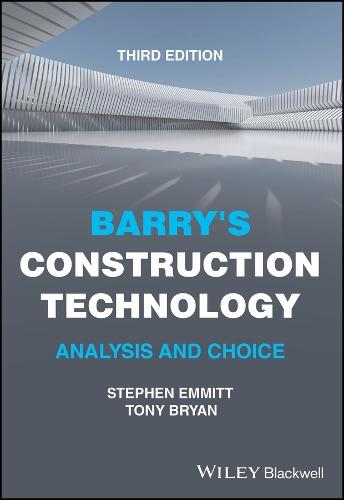Overview
Updated resource guiding readers through the analysis and choices required to ensure a building will perform as expected Robin Barry’s Construction of Buildings was first published in 1958 as a five-volume set and rapidly became a standard work on the subject. Following Barry’s death in 2002, a two-volume format was adopted with new authors. Developed from an earlier book by Tony Bryan, this new third volume, Barry’s Construction Technology, extends the coverage to show how decisions about the design, production, maintenance and disposal of buildings may be thought through given the materials and technology available. The book challenges the reader to think about the consequences of making choices and decisions rather than relying on using what has been used before. Barry’s Construction Technology: Analysis and Choice includes information on: The climate emergency and the low carbon agenda as a fundamental part of construction technology analysis and choice Regenerative design, net zero buildings, and the circular economy for the built environment Constraints that location, legislation, codes and standards, sustainability, insurance, and commercial pressures apply to the performance of buildings Specific construction technology examples, with emphasis on questioning what we do and why, with the aim of informing and stimulating the reader to ask questions when confronted with all design and construction projects Barry’s Construction Technology: Analysis and Choice is an essential, practical, and up-to-date reference for undergraduate students of all building construction programmes including surveying, construction management, architectural technology, and architecture.
Full Product Details
Author: Stephen Emmitt (University of Bath, United Kingdom) ,
Tony Bryan (United Kingdom)
Publisher: John Wiley & Sons Inc
Imprint: Wiley-Blackwell
Edition: 3rd edition
Dimensions:
Width: 17.10cm
, Height: 2.20cm
, Length: 24.30cm
Weight: 0.635kg
ISBN: 9781394264643
ISBN 10: 139426464
Pages: 304
Publication Date: 18 September 2025
Audience:
College/higher education
,
Professional and scholarly
,
Undergraduate
,
Professional & Vocational
Format: Paperback
Publisher's Status: Active
Availability: Available To Order

We have confirmation that this item is in stock with the supplier. It will be ordered in for you and dispatched immediately.
Author Information
Stephen Emmitt is Professor of Architectural Practice at the Department of Architecture and Civil Engineering, University of Bath, UK. He was previously Head of Department and Director of the Centre for Advanced Studies in Architecture (CASA). He is an architect with industrial experience. His research and teaching interests cover the interface between design and construction, design management, and collaborative working.



